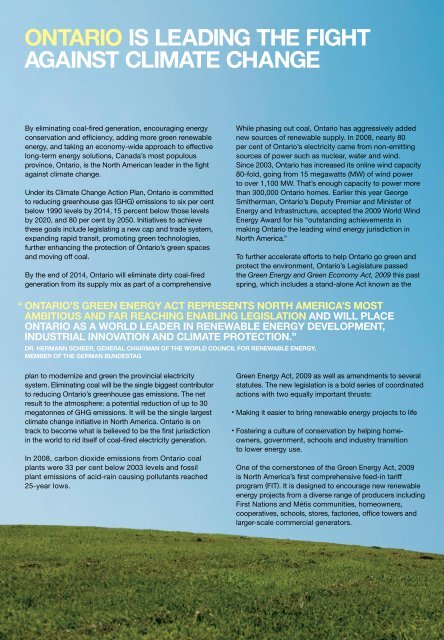Climate Action 2009-2010
You also want an ePaper? Increase the reach of your titles
YUMPU automatically turns print PDFs into web optimized ePapers that Google loves.
ONTARIO Is leAdINg The fIghT<br />
AgAINsT clImATe chANge<br />
By eliminating coal-fired generation, encouraging energy<br />
conservation and efficiency, adding more green renewable<br />
energy, and taking an economy-wide approach to effective<br />
long-term energy solutions, Canada’s most populous<br />
province, Ontario, is the North American leader in the fight<br />
against climate change.<br />
Under its <strong>Climate</strong> Change <strong>Action</strong> Plan, Ontario is committed<br />
to reducing greenhouse gas (GHG) emissions to six per cent<br />
below 1990 levels by 2014, 15 percent below those levels<br />
by 2020, and 80 per cent by 2050. Initiatives to achieve<br />
these goals include legislating a new cap and trade system,<br />
expanding rapid transit, promoting green technologies,<br />
further enhancing the protection of Ontario’s green spaces<br />
and moving off coal.<br />
By the end of 2014, Ontario will eliminate dirty coal-fired<br />
generation from its supply mix as part of a comprehensive<br />
While phasing out coal, Ontario has aggressively added<br />
new sources of renewable supply. In 2008, nearly 80<br />
per cent of Ontario’s electricity came from non-emitting<br />
sources of power such as nuclear, water and wind.<br />
Since 2003, Ontario has increased its online wind capacity<br />
80-fold, going from 15 megawatts (MW) of wind power<br />
to over 1,100 MW. That’s enough capacity to power more<br />
than 300,000 Ontario homes. Earlier this year George<br />
Smitherman, Ontario’s Deputy Premier and Minister of<br />
Energy and Infrastructure, accepted the <strong>2009</strong> World Wind<br />
Energy Award for his “outstanding achievements in<br />
making Ontario the leading wind energy jurisdiction in<br />
North America.”<br />
To further accelerate efforts to help Ontario go green and<br />
protect the environment, Ontario’s Legislature passed<br />
the Green Energy and Green Economy Act, <strong>2009</strong> this past<br />
spring, which includes a stand-alone Act known as the<br />
“ ONTARIO’s gReeN eNeRgy AcT RepReseNTs NORTh AmeRIcA’s mOsT<br />
AmbITIOus ANd fAR ReAchINg eNAblINg legIslATION ANd wIll plAce<br />
ONTARIO As A wORld leAdeR IN ReNewAble eNeRgy develOpmeNT,<br />
INdusTRIAl INNOvATION ANd clImATe pROTecTION.”<br />
dR. heRmANN scheeR, geNeRAl chAIRmAN Of The wORld cOuNcIl fOR ReNewAble eNeRgy,<br />
membeR Of The geRmAN buNdesTAg<br />
plan to modernize and green the provincial electricity<br />
system. Eliminating coal will be the single biggest contributor<br />
to reducing Ontario’s greenhouse gas emissions. The net<br />
result to the atmosphere: a potential reduction of up to 30<br />
megatonnes of GHG emissions. It will be the single largest<br />
climate change initiative in North America. Ontario is on<br />
track to become what is believed to be the first jurisdiction<br />
in the world to rid itself of coal-fired electricity generation.<br />
In 2008, carbon dioxide emissions from Ontario coal<br />
plants were 33 per cent below 2003 levels and fossil<br />
plant emissions of acid-rain causing pollutants reached<br />
25-year lows.<br />
Green Energy Act, <strong>2009</strong> as well as amendments to several<br />
statutes. The new legislation is a bold series of coordinated<br />
actions with two equally important thrusts:<br />
• Making it easier to bring renewable energy projects to life<br />
• Fostering a culture of conservation by helping homeowners,<br />
government, schools and industry transition<br />
to lower energy use.<br />
One of the cornerstones of the Green Energy Act, <strong>2009</strong><br />
is North America’s first comprehensive feed-in tariff<br />
program (FIT). It is designed to encourage new renewable<br />
energy projects from a diverse range of producers including<br />
First Nations and Métis communities, homeowners,<br />
cooperatives, schools, stores, factories, office towers and<br />
larger-scale commercial generators.












